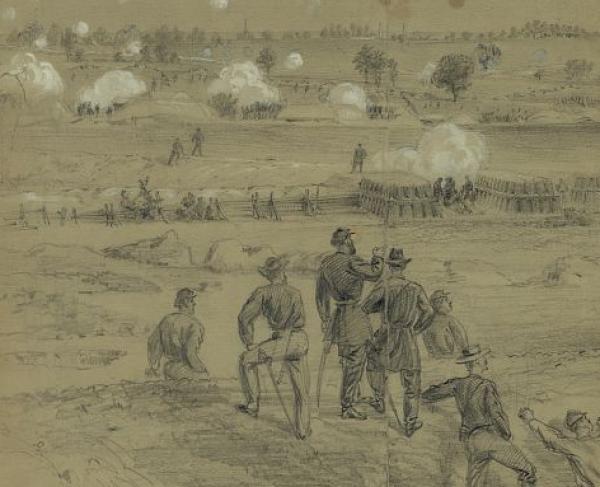Bringing the War to an End: Traditional Elementary Civil War Lesson Plan

Grades: Elementary
Approximate Length of Time: 90 minutes
Goal: Students will be able to list the sequence of events leading to the end of the Civil War, paying special attention to the election of 1864.
Objectives:
- Students will list the sequence of events leading to the end of the war and place each event on a map.
- Students will engage in group and class debates over the issues of the 1864 election.
- After reading a portion of The Last Salute of the Army of Northern Virginia, students will discuss U.S. soldier’s feelings toward Confederate soldiers.
- Students will be able to answer the question, “What did it take to bring the Civil War to an End?”
Common Core Standards:
CCSS.ELA-LITERACY.RI.4.1
Refer to details and examples in a text when explaining what the text says explicitly and when drawing inferences from the text.
CCSS.ELA-LITERACY.RI.4.9
Integrate information from two texts on the same topic in order to write or speak about the subject knowingly.
NCSS Standards for Social Studies:
1—Culture
2—Time, Continuity, and Change
3—People, Places, and Environment
5—Individuals, Groups, and Institutions
6—Power, Authority, and Governance
10—Civics, Ideals, and Practices
Materials:
- Bringing the War to an End PowerPoint
- Timeline and Map Worksheet
- Lincoln & McClellan Cards
- The Chicago Platform
- The Baltimore Platform
- What Do You Think?
- What Do You Think Teacher Questions
- The Last Salute of the Army of Northern Virginia
ANTICIPATORY SET/HOOK:
By the end of 1863 the situation is looking up for the United States, with Union victories at Vicksburg and Gettysburg; however, some people are tired of war and are looking for a way to end it soon.
Lincoln will soon complete one four-year term as president. How do you think the election is going to go? Do you think Lincoln will be reelected or will someone else become president? While Lincoln believes that it is important to keep fighting to bring the Southern states back into the Union, what do you think his opponents might argue?
Procedure:
- Throughout the lesson, follow the Bringing the War to an End PowerPoint.
- The PowerPoint will provide prompts for when to do the activities.
- There are online videos referred to in the PowerPoint that should be queued ahead of time.
- There may be words, locations, or people that the students do not know mentioned throughout the lesson. Let them know that this is a normal part of learning history and like any good historian, they should identify what they don’t know and do a bit of research (most times this research can be done in a few minutes).
Activity 1
- Provide the Timeline and Map Worksheet, copied back to back.
- Have students fill in the Timeline and map.
- On the map they can draw lines from one battle location to another if they are part of a campaign.
Activity 2
- Hand out the Lincoln & McClellan Cards to students; there should be roughly the same number of Lincolns and McClellan’s.
- Hand out the Baltimore Platform and the Chicago Platform.
- Read the documents together as a class, have the students write down the resolutions in their own words (just a few quick notes on the war related resolutions)
- Put all of the Lincolns in one group and all of the McClellans in another.
- Hand out the What Do You Think? Worksheet, and have students work together to gather their ideas for a debate, filling out the note sheet as they go.
- Moderate the debate using the What Do You Think Teacher Questions.
Closure:
As a class, read the excerpt from U.S. Brigadier General Joshua Lawrence Chamberlain’s Last Salute of the Army of Northern Virginia and discuss the related questions.
If there is an inquiry question in this lesson it would be: What did it take to bring the war to an end? This can be a great way to end your discussion of the lesson.
Assessment in This Lesson:
- Completed timeline
- Completed map
- Informal evaluation during the Lincoln/McClellan debate.
- Notes on the What Do You Think? worksheet.
- Written responses to the questions on the Last Salute of the Army of Northern Virginia.


